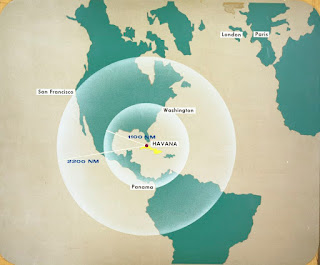Finds from the Far East Broadcasting Company Digital Archives: Missionary Radio and the Cuban Missile Crisis
 |
| Map showing potential ranges of Soviet MRBM and IRMB missiles from Cuba. Source: JFK Library |
President Kennedy requested ten radio stations with the range to reach Cuba, including FEBC shortwave station KGEI in San Carlos, California, to broadcast hours of Voice of America (VOA) programming throughout the crisis as well as his October 22 speech. This speech included a direct message to the Cuban people:
Finally, I want to say a few words to the captive people of Cuba, to whom this speech is being directly carried by special radio facilities. I speak to you as a friend, as one who knows of your deep attachment to your fatherland, as one who shares your aspirations for liberty and justice for all. And I have watched and the American people have watched with deep sorrow how your nationalist revolution was betrayed-- and how your fatherland fell under foreign domination. Now your leaders are no longer Cuban leaders inspired by Cuban ideals. They are puppets and agents of an international conspiracy which has turned Cuba against your friends and neighbors in the Americas--and turned it into the first Latin American country to become a target for nuclear war--the first Latin American country to have these weapons on its soil.The speech reflected the anti-communist stance of the Kennedy administration. Drawing links between democratic governance, liberal capitalism, and support for religious freedom, American leaders such as Kennedy sought to highlight the differences between the United States and the atheistic, communist Soviet Union and its client states. In an atmosphere of Cold War competition—which included the arms race as well as the ideological battle for "hearts and minds" in Latin America, Africa, Asia, and the Middle East—such rhetoric took on considerable importance.
These new weapons are not in your interest. They contribute nothing to your peace and well-being. They can only undermine it. But this country has no wish to cause you to suffer or to impose any system upon you. We know that your lives and land are being used as pawns by those who deny your freedom.
Many times in the past, the Cuban people have risen to throw out tyrants who destroyed their liberty. And I have no doubt that most Cubans today look forward to the time when they will be truly free--free from foreign domination, free to choose their own leaders, free to select their own system, free to own their own land, free to speak and write and worship without fear or degradation. And then shall Cuba be welcomed back to the society of free nations and to the associations of this hemisphere. [1]
The missile crisis ended on October 28, when Khrushchev agreed to remove the missiles from Cuba. In early December 1962, Kennedy invited the station owners who had broadcast the speech and VOA programs to the White House to receive a special commendation for their patriotism and contributions to national security. Robert Bowman, the president of the Far East Broadcasting Company was one of the ten station owners who received this commendation.
 |
| The certificate that President John F. Kennedy presented to FEBC President Robert H. Bowman in a special ceremony at the White House. Image used with permission from the FEBC Archives. |
Aside from highlighting an interesting moment in the history of the roles that evangelical Christian organizations have played in U.S. foreign relations, the story also reveals the tremendous growth that American missionary radio stations had experienced by the 1960s. FEBC had begun broadcasting Christian programming from the Philippines in 1948, using a small 1000-watt transmitter with a limited range. Eager to share the Gospel with the millions of unreached people throughout the world, the FEBC and other similar missionary radio stations expanded their operations considerably throughout the decades that followed. By the 1960s, FEBC was broadcasting evangelistic programming in dozens of languages and dialects on transmitters that could reach radios across Latin America, Asia, and the Soviet Union. The story of this expansion is one that blends the histories of missionary work with the histories of technology, globalization, informal empire, and international relations during the Cold War.
Since these stories make up part of my book manuscript, I was delighted to come across the digital archive that the FEBC maintains. The archive includes a fascinating array of photographs, documents, and radio programs that have been digitized. According to the site, “The Archive consists of digital representations of audio, scanned photographs, documents, objects, and copies of digital images which represent the life of FEBC, including images of events influencing its founding in 1946 to the present. This archive was originally compiled and designed by Jim Bowman of International Christian Radio Associates after his retirement from FEBC. Not only is Jim the son of Robert Bowman, co-founder of Far East Broadcasting Company, he held a number of positions within FEBC including president of FEBC USA. The initial focus of the archive by Jim Bowman was collecting documentation from the first twenty years of FEBC's development, 1946 to about 1965." It is keyword searchable but also fascinating to browse. For historians of religion interested in the history of missionary radio, this is a really exciting resource.
[1] John F. Kennedy, Public Papers of the Presidents of the United States: John F. Kennedy; Containing the Public Messages, Speeches, and Statements of the President, 1961-1963 (Washington: U.S. G.P.O., 1962), 486. For the text of the full speech, follow this link.
Note: since some of the material in the archive is sensitive, I strongly encourage anyone interested in using the materials for publication to contact the FEBC for permissions.



Comments